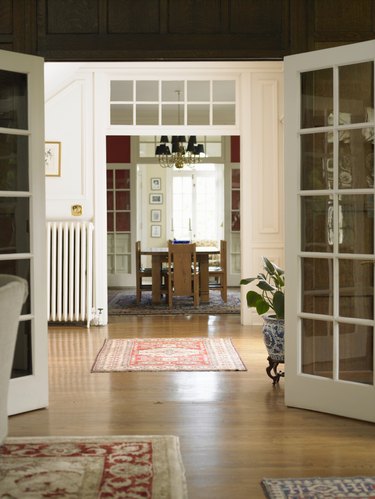
An area rug that refuses to stay put isn't just an annoyance, it's a safety hazard. Rugs placed on hardwood, laminate and tile floors are the most prone to slipping and sliding, but the problem needs to be remedied no matter your flooring type. Rug pads, special gripper tape and rug backings, either purchased or appropriately improvised, are the simplest solutions.
What Are Rug Pads?
Video of the Day
Rug pads, also known as rug liners and rug grips, are available at major home goods stores and specialist rug and carpet sellers. Different types of rug pads are designed for use on hard floors, such as hardwood, laminate and tile, and for carpets, as well as outdoor surfaces. Non-slip rug pads, which are generally made of natural or synthetic rubber, have a waffle or mesh-like texture. Purchase these pads approximately 1 inch smaller on all sides than your rug, or choose one that is slightly larger and trim it to size with scissors. The pad lies between the rug and the floor without being permanently attached to either. Rug pads made of 100 percent felt offer cushioning but will not prevent rugs from slipping and sliding; however, some premium pads have felt on one side for cushioning and rubber on the other side for traction.
Video of the Day
Rug Pad Pros and Cons
Rug pads offer a number of benefits in addition to preventing rugs from slipping, according to this article, Why Do I Need a Rug Pad? They prevent rugs from bunching, offer extra cushioning, muffle noise and protect floors from wear and tear, as well as curtailing dye transfer. They may also be necessary to keep warranties on expensive rugs valid. Very large and custom-size rug pads can be expensive compared to other options. Rug pads that are sold folded, rather than rolled, might take some time to smooth down.
Shelf Liner
You might notice the resemblance between rubber rug pads and inexpensive rolls of rubber shelf liner. If your rug is small enough, shelf liners can make an adequate substitute for the real thing. Shelf liners are easy to trim to size with scissors, and they offer the same non-skid benefits as rug pads.
Gripper Tape
Another inexpensive alternative to rug pads is special gripper tape, which is sold in a roll and is suitable for all floor types. The tape has a mesh-like structure and is sticky on both sides. Cut lengths of tape and adhere them along the edges of the underside of the rug. Stick additional lengths across the middle also if you wish. Peel off the plastic covering and press the rug into position on the floor. The tape is tacky enough to hold the rug in place on any surface, but it still allows you to move the rug when necessary and shouldn't leave any residue on the floor or carpet. It might, however, loosen its grip over time and need to be replaced.
Improvised Options
Rug-making sections of well-stocked craft stores sell jars of liquid rubber latex specifically for use as non-slip rug backing. Apply the product to the reverse side of your rug using a paintbrush, following the manufacturer's directions. Spray-on versions of this product are also available. Another DIY option to create a non-slip rug backing uses latex or silicone caulk, which is sold in home improvement stores, and is demonstrated in this DIY Nonslip Rug video. Squeeze lines of caulk around the perimeter and across the back of the rug, about a hand's-width apart, and wait for it to dry before turning the rug the right way around. To avoid lumpy lines underfoot, especially with thinner rugs, smooth out the caulk lines with a putty knife before they dry.